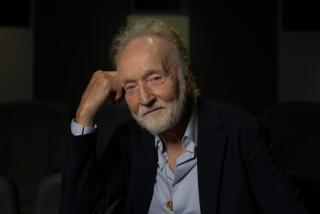Through his eyes
It’s hard to say what’s most unexpected about “The Diving Bell and the Butterfly,” Julian Schnabel’s deeply affecting version of the internationally bestselling memoir: that the results are as exceptional as they are or, frankly, that the film has been made at all. Even Daniel Battsek, who acquired it for Miramax, admits he reacted with “fear and trepidation” when he heard the book was being filmed.
That’s because Jean-Dominique Bauby’s 1997 memoir is one of the most unusual of modern times. The author dictated it, letter by letter, by blinking his left eye. That was the only part of Bauby’s body that was not paralyzed after he suffered a catastrophic stroke that left him with “locked-in syndrome”: his perfectly functioning brain was trapped in an inert body, the equivalent, Bauby felt, of being encased in one of those old-fashioned diving bells.
A story like this would seem almost impossible to film. And even if you figured out a way to do it, how would you prevent it from becoming one of those schematic, overly sentimental “triumph of the human spirit” efforts that send sane viewers screaming for the exits?
Starting from Ronald Harwood’s script, filmmaker Schnabel, who learned French to make the story in its original language and won the best director prize at Cannes for his trouble, has avoided the obvious pitfalls and made virtues out of necessities. His imaginative and sensitive film, starring France’s gifted Mathieu Amalric, is simultaneously uplifting and melancholy, suffused with an unexpected sense of possibility as much as the inevitable sense of loss.
This has happened in part because Schnabel, though he’s directed two other films, is at his core a visual artist. Working with the exceptional Oscar-winning cinematographer Janusz Kaminski, he has infused the proceedings with the kind of imaginative feeling for rich and fecund imagery he brought to his earlier “Before Night Falls.”
More than that, Schnabel famously has the same kind of enthusiasm for life that characterized Bauby, the pleasure-loving former editor of French Elle known to his friends as Jean-Do, who wrote “I need to feel strongly, to love and to admire, just as desperately as I need to breathe.”
So it was out of the question that “Diving Bell” was going to be anything but the most alive film its creators could imagine. As Schnabel related at Cannes, “My wife said, ‘Give me a break. You always make movies about people who are dying or dead.’ I didn’t see it like that. I said, ‘It’s going to be really funny.’ ”
In point of fact it often is. That’s because “Diving Bell” has taken pains to retain the fearlessly sarcastic tone of the author, who gleefully compares early attempts by therapists to bundle him into a wheelchair to “movie gangsters struggling to fit the slain informer’s body into the trunk of their car.” Given the comic fearlessness of Bauby’s savage, exasperated comments about what’s happening to him and the formidable way Amalric delivers the lines, feelings of morose helplessness don’t stand a chance.
It was screenwriter Harwood’s astute idea to imagine that, in the words of the script, “The camera is Jean-Dominique Bauby.” A major part of the film is shot from the paralyzed man’s point of view, with Amalric creating intimacy by providing a running commentary of his thoughts that only viewers can hear.
Initially Bauby doesn’t know where he is or what’s happened to him. A no-nonsense doctor tells him he’s at the naval hospital in Berck-sur-Mer near Normandy (the film used the real location) and informs him of his condition, which he can barely believe. Told of the efforts made to bring him back to life, we hear him scream inside his head, “This is life?”
Shooting from Bauby’s point of view has another advantage: It enables the film to avoid showing us what the paralyzed man looks like full-on for almost an hour. By the time we completely see Bauby, coming across, he himself waspishly says, “like I came out of a vat of formaldehyde,” we have so warmed to him that his appearance is easier to take.
What we see instead are close-ups of all the women in Bauby’s life, and it is the film’s shrewd notion to make each one more beautiful than the next. These include Celine (Emmanuelle Seigner), the mother of his children, and a trio of women who are critical to his rehabilitation, as well as a flashback to a former mistress (“Lady Chatterley’s” Marina Hands). Though Bauby’s book says little about either his ex-wife or his mistress, that is one area in which the film fabricates scenes and situations to make things more dramatic.
One of the film’s memorable scenes is a flashback to the last time Bauby sees his 92-year-old father, effectively played by Max von Sydow, when Jean-Do gives the aging man a shave. It’s a wonderfully unhurried, intimate moment that typifies the natural, sensitive performances that Schnabel has been able to get out of his cast.
Though his character moves only in these flashbacks, Amalric utilizes his voice and his brilliantly alive left eye to create a memorable individual, someone who makes use of his memory and his imagination, both unimpaired, to allow his mind to “take flight like a butterfly.”
The key relationships Bauby has are with the women who assist him in communicating with the world. At the hospital there is speech therapist Marie (Olatz Lopez Garmendia, Schnabel’s wife) and Henriette (the wonderful Quebec-born Marie-Josee Croze), the woman who came up with an ingenious way for the paralyzed man to speak his mind.
Henriette constructed a board that lists the letters of the alphabet by the frequency by which they come up in French. The letters are spoken aloud (“a hit parade” Bauby calls it in his book) and he blinks at the one he wants. Eventually he becomes so proficient in this system, that Claude (Anne Consigny), yet another beautiful woman, is hired to take his unusual dictation.
Perhaps the most unexpected thing about “Diving Bell” is that this constant repetition of spoken letters, which sounds tedious in the abstract, becomes, because of the use of the supremely melodic French language, an almost sensual pleasure. Finally finished with his pages, Bauby anxiously blinks the question, “Does that make a book?” Indeed it does, and a most unexpected film as well.
“The Diving Bell and the Butterfly.” MPAA rating: PG-13 for nudity, sexual content and some language. Running time: 1 hour, 52 minutes. In French with English subtitles. In limited release.
More to Read
Only good movies
Get the Indie Focus newsletter, Mark Olsen's weekly guide to the world of cinema.
You may occasionally receive promotional content from the Los Angeles Times.









